Shoulder Replacement Surgery
Shoulder Replacement Surgery in India:
Our shoulder is one of the extensively used joints in our body and it also is complex due to its 360-degree mobility function. Unlike our knee or ankle joint, our shoulder joint is used for multiple functions. A patient may need shoulder replacement surgery or Arthroscopic Shoulder Surgery intervention due to damage caused by wear and tear or trauma or osteoarthritis. Know more about Shoulder Replacement Surgery In India i.e. the Shoulder replacement surgery cost in India and other useful information about it.
Detailed Cost Of Shoulder Replacement Surgery In India:
India is one of the countries in the world where you can undergo shoulder replacement surgery at an affordable cost. The table below shows the shoulder replacement surgery cost which is under 5000 USD.
| Total Shoulder Replacement Surgery (USD) | Reverse Shoulder Replacement Surgery (USD) | Partial Shoulder Replacement Surgery (USD) |
|---|---|---|
| $4900 | $4900 | $4000 |
Download A Checklist to plan your treatment in India
When is Shoulder Replacement Surgery Required?
Shoulder pain may involve the cartilage, ligaments, muscles, nerves, or tendons. It can also include the shoulder blade, neck and arm. Some conditions that may require shoulder replacement surgery include severe shoulder arthritis and rotator cuff tears. In case of a shoulder injury then a shoulder replacement may be the best option. During this procedure, both sides of the ball-and-socket shoulder joint are replaced with artificial parts. Other surgical procedures may include fixation of fractures, repair of tears and removal of bone spurs.
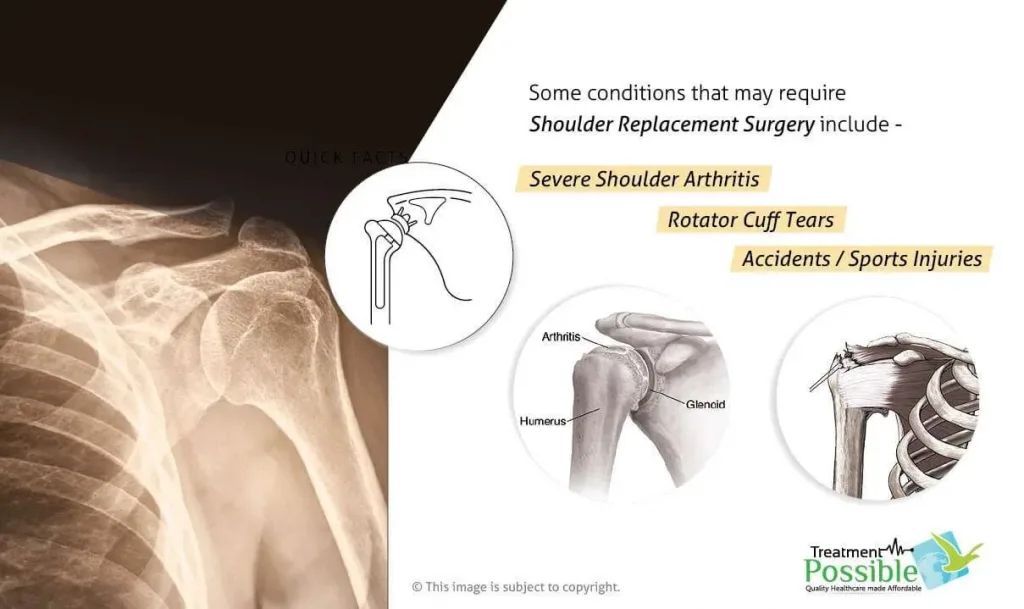
What is a Total Shoulder Replacement?
Total shoulder replacement surgery is a complex procedure that involves replacing the shoulder joint with artificial parts. The procedure is performed to relieve pain and improve mobility.
Shoulder replacement surgery is usually recommended for people who have severe pain in their shoulder, some conditions are as below:
- Osteoarthritis: This type of arthritis is common in older people. It occurs when the cartilage that pads bones wear away.
- Rheumatoid arthritis (RA): With RA, your immune system mistakenly attacks your joints, causing pain and inflammation.
- Avascular necrosis: This condition happens when the loss of blood to a bone occurs. It can cause damage and pain in the shoulder joint.
- A broken shoulder: If you badly break your shoulder bone, you might need a shoulder replacement to repair it.
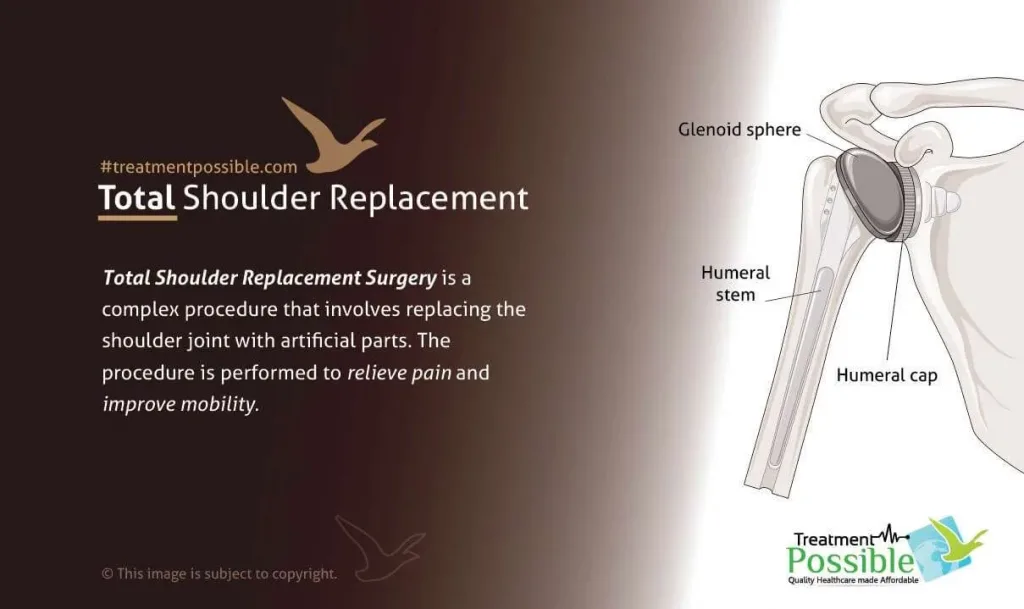
What Happens During a Total Shoulder Replacement?
Shoulder replacement surgery generally takes about two hours. During the surgery, doctors replace the damaged joint “ball,” known as the humeral head, of the shoulder with a metal ball. They also place a plastic surface on the “socket” of the shoulder, known as the glenoid. Sometimes, partial shoulder replacement surgery can be performed. This involves replacing only the ball of the joint.
What is the Expected Outcome of a Shoulder Replacement?
Shoulder replacement surgery is a major operation, so you’ll likely experience pain during your recovery. Rehabilitation is started right away, usually on the day of surgery. You should be prepared to have less arm function for about a month after surgery. You’ll need to be careful not to lift any heavy objects. You should also avoid activities that require pushing or pulling. The average recovery time for shoulder surgery is 2 to 6 weeks after which a person can resume daily activities.
The cost of total shoulder replacement surgery in India is $4900.
What are the Complications and Risks involved in Total Shoulder Replacement?
The risks and complications involved may vary depending on the anatomy of your shoulder problem. Some of these risks may be higher in people having repeat surgery.
- Damage to the surrounding nerves (which might impair arm movement).
- Rotator Cuff Tear.
- Fracture of one of the shoulder bones.
- Dislocation of the artificial joint.
- Infection.
Before having any surgery, we advise you to speak with your surgeon about the risks and benefits of the procedure and the results you can expect. Take your time to make an informed choice. It is important to fully understand what is required in your post-surgical rehabilitation. At Treatment Possible we help you plan for your shoulder replacement surgery in India i.e. cost, treatment options, best shoulder surgeons in India and hospitals. Know More.
Want more clarification about medical expense & treatment plan?
Plan for Total shoulder Replacement In India
What is a Reverse Shoulder Replacement?
During reverse shoulder replacement surgery, both sides of the ball-and-socket shoulder joint are replaced with artificial parts.
The shoulder joint is made up of the upper arm bone (humerus) and the shoulder blade (scapula). The rounded end of the upper arm bone moves inside a shallow socket in the shoulder blade. Because of this, your shoulder normally has a very wide range of motion. Cartilage, tendon, and ligaments around the joint also provide support and help the joint move smoothly.
In a reverse shoulder replacement surgery, the surgeon removes the head of the upper arm bone. The plastic socket would be attached to the remaining bone with screws. The surgeon would remove a part of the socket of the shoulder blade and replace it with a metal ball.
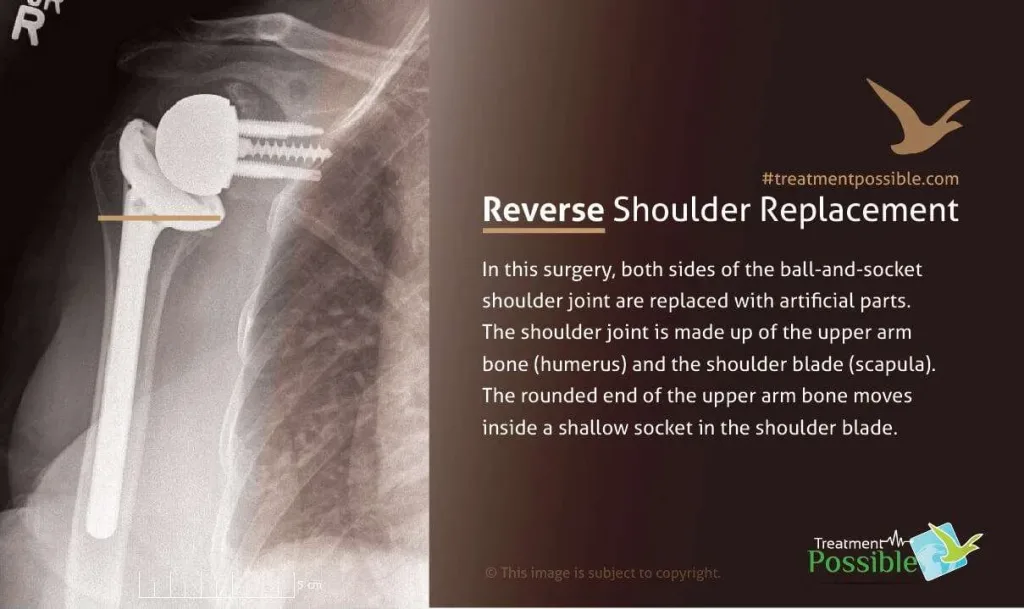
What is the difference between Reverse and Total Shoulder Replacement ?
Surgery may be an option for you if you have severe pain that gets in the way of everyday activities. Most people get a standard total shoulder replacement surgery. However, reverse shoulder replacement surgery works better for people with certain injuries, including some rotator cuff injuries. If you have this type of injury, a standard shoulder replacement surgery still might leave you with some pain and limited movement. A reverse total shoulder replacement surgery usually improves these problems. After surgery, instead of using the rotator cuff to lift your arm, you can use your deltoid muscle. This is a muscle that helps lift the arm up and away from the body.
Structure of an Anatomy of the Shoulder:
The shoulder consists of bones, joints and muscles. The muscles act to provide the widest range of motion of any part of the body and it helps to stabilize the three joints of the shoulder while moving.
There are three major bones which connect at the shoulder and create a 90-degree angle:
- Clavicle: It helps stabilize the shoulder’s movements. This is also known as the collarbone.
- Scapula: It connects with the Clavicle, this is also known as the shoulder blade.
- Humerus: The humerus connects to the scapula and clavicle in the shoulder.
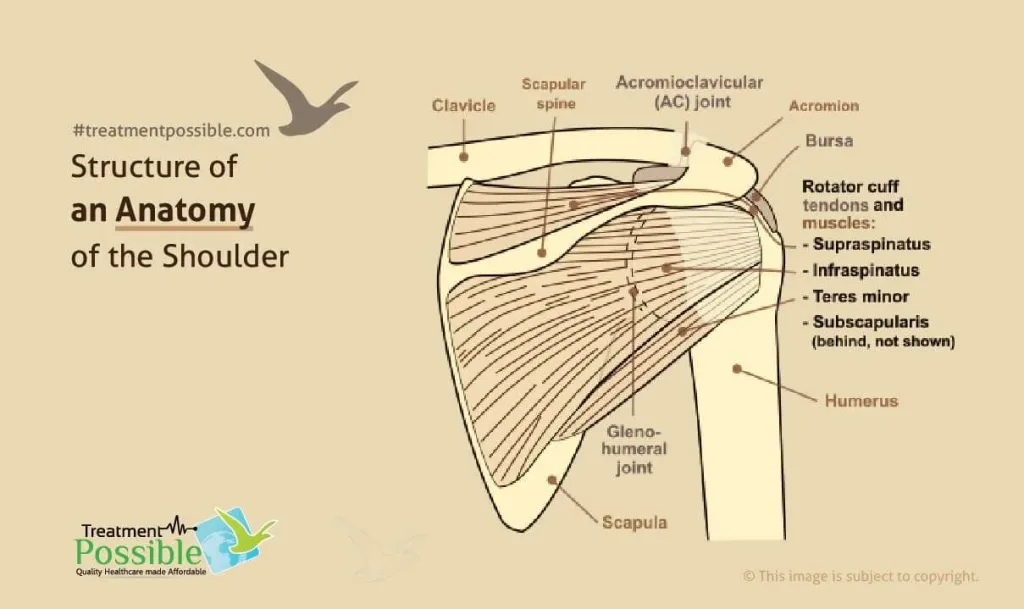
The junctions of these three bones with the sternum (chest bone) form three joints:
- Glenohumeral joint: This ball and socket joint like structure created by the humerus and scapula allow the arm to rotate. It is surrounded by soft tissue and strengthened by fibrous ligaments.
- Acromioclavicular (AC) joint: This joint provides the ability to raise the arm above the head. The meeting of the scapula and clavicle forms it.
- Sternoclavicular joint: This joint is at the center of the chest where the clavicle meets the sternum. It allows the clavicles to move.
How is a Reverse Shoulder Replacement Performed?
If the rotator cuff is severely damaged the joint may not work properly because the tendons are severely damaged, therefore a reverse shoulder replacement can improve the joints function and reduce pain. In a reverse shoulder replacement surgery, the normal ball and socket structure is reversed, an artificial ball is attached to the shoulder blade and an artificial socket is attached to the arm bone.
During the procedure, the surgeon:
- Step 1: Makes an incision in front of the arm, and the muscles and tendons are moved away from the joint. Then the upper arm bone is removed from the socket.
- Step 2: The surgeon cuts the top of the arm bone and an artificial socket is attached to the top of the arm bone.
- Step 3: The socket is also prepared and an artificial ball is attached to the shoulder blade.
- Step 4: The metal stem is inserted in the arm bone and a plastic socket is attached to the top of the arm bone.
- Step 5: After the artificial parts are placed, the tendons and muscles are carefully put back to their normal position.
What to expect after a Reverse Shoulder Replacement?
You will have some pain as you heal after the surgery. But your original shoulder pain should be improved. Following the surgery, your arm will be in a sling for several weeks and physical therapy exercises are done while you are still in the hospital. You will probably need to stay in the hospital for 2 to 3 days. You won’t be able to use your arm for several weeks, though. You can return to light work within a few weeks.
The cost of reverse shoulder replacement surgery in India is $4900.
Want more clarification about medical expense & treatment plan?
Plan for Reverse shoulder Replacement In India
What is Partial Shoulder Replacement Surgery?
A partial shoulder replacement surgery involves replacing the damaged humeral head which is the top of the upper arm bone, but not the socket portion of the shoulder blade. Generally recommended when the humeral head is arthritic or fractured, partial shoulder replacement surgery is performed to take a more conservative approach in repairing the shoulder, than a total shoulder replacement surgery. During the consultation, the physician can determine if shoulder replacement is right for you.
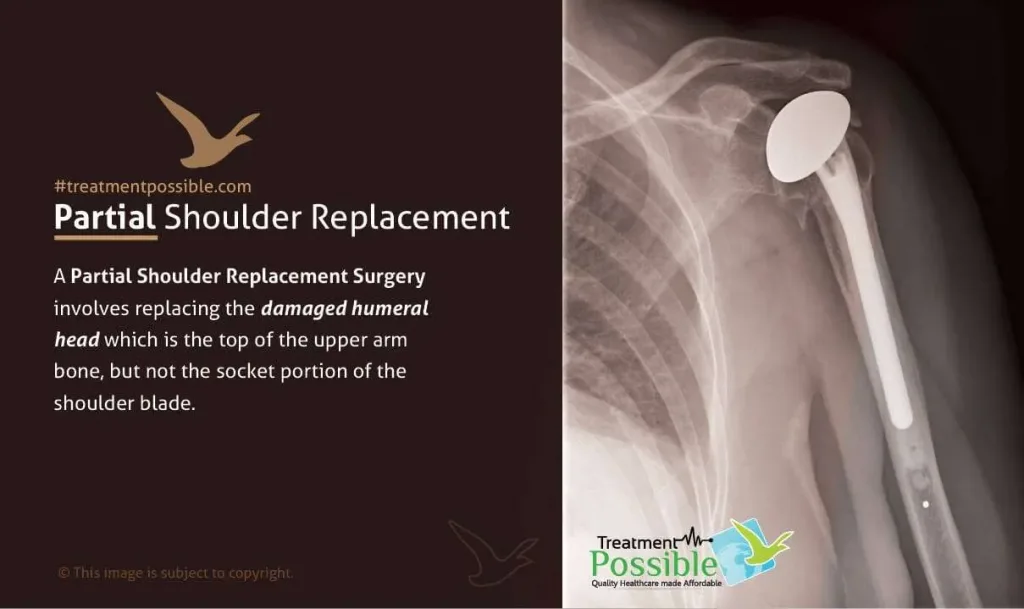
Who is Eligible for Partial Shoulder Replacement Surgery?
The candidates for partial shoulder replacement surgery will experience severe pain when attempting to accomplish normal activities like getting dressed or reaching up to grab something from a cabinet. The candidates will also experience a loss of motion in their shoulder. These painful symptoms can be due to injury, arthritis, or other conditions.
Most importantly, partial shoulder replacement surgery candidates will find that their pain level does not improve with the use of conservative treatments such as cortisone injections or physical therapy. Patients should be in good overall health, with no active infections.
For patients with persistent shoulder pain, x-rays are taken to determine the condition of the joint. Computerized tomography (CT) scan or MRI is taken for a closer look at the patient’s shoulder. In some cases, doctors may try using a steroid injection to manage the pain, but if this proves ineffective, surgery may be the next best option for providing relief.
How is Partial Shoulder Replacement Surgery performed?
The partial shoulder replacement surgery is similar to a total shoulder replacement surgery. In some cases, the doctor may have to wait until he has made incisions and exposed the shoulder joint to determine which procedure is necessary.
- Step 1 – If the humeral head has severe fractures or is arthritic, but the glenoid socket is healthy, he will recommend partial replacement surgery.
- Step 2 – This procedure involves creating an incision along the shoulder and upper arm, allowing the doctor to separate the deltoid and pectoral muscles.
- Step 3 – After incision of the anterior rotator cuff muscle, he will have access to the damaged part of the shoulder.
- Step 4 – The doctor will then remove the damaged portion of the humeral head, replacing it with a metal ball attached to a stem that extends into the humerus. Finally, he will suture the incisions.
What is the outcome for Partial Shoulder Replacement Surgery?
The patient will need to keep the arm immobilized in a sling, except while showering or participating in rehabilitation exercises. Within six weeks, most patients regain light use of their arm and shoulder and fully recover in as little as eight weeks. Patients can return to desk work in two or three weeks but may need to wait four months or longer before resuming more physically demanding duties.
While the condition of the muscles and tendons plays a significant role in recovery, most patients find that by three months after surgery, they are fairly comfortable. They may experience some weakness and will have half of their normal range of motion restored. Within six months, they experience about two-thirds of their original motion and strength and remain pain-free. A year after surgery, most patients find they have full strength and no pain.
The cost of partial shoulder replacement surgery in India is $4900.
Want more clarification about medical expense & treatment plan?
Plan for Partial shoulder Replacement In India
How can I Avail Reverse Shoulder Replacement in India?
Treatment Possible is associated with the Top shoulder replacement surgeons in India who specialize in affordable shoulder replacement surgery. We only work with Hospitals that are equipped with OT that are compatible with complex shoulder surgeries. Not all surgeons can perform advanced Shoulder Surgery in India so Treatment Possible only associates with the best shoulder surgeons in India and Hospitals who are experienced in operating complex Shoulder replacement cases and ensure a successful surgery.
Treatment Possible shall ensure high-quality shoulder replacement Surgery in India while guaranteeing the lowest medical services and surgery cost, especially for Reverse shoulder replacement surgery. Our understanding of the Indian Medical Services and Healthcare market and our valued relations with the best shoulder replacement surgeons enables us to provide the treatment at a price that is reasonable, affordable and transparent.
The results of the Shoulder replacement surgeries in India arranged by us have been mostly positive. It is very important to undergo all the prescribed tests based on medical history so that the doctors can determine the perfect medical solution yet manage to keep surgery cost low.
Get Free Consultation with chosen Top Reverse shoulder replacement surgeons in India with the hassle-free setup of post-operative recovery care, medical travel & stay during the Medical treatment. Check out more valuable information about Reverse Shoulder Replacement Surgery in India by calling and talking to us.
You can also send your medical reports for Shoulder replacement Surgery to care@treatmentpossible.com for free opinions and suggestions from the best shoulder replacement surgeons in India. No matter what the health condition, you always get good healthcare options and cost advantage from Treatment Possible.
